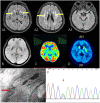Case Report: Progressive Asymmetric Parkinsonism Secondary to CADASIL Without Dementia
- PMID: 35082744
- PMCID: PMC8785823
- DOI: 10.3389/fneur.2021.760164
Case Report: Progressive Asymmetric Parkinsonism Secondary to CADASIL Without Dementia
Abstract
Parkinsonism is a rare phenotype of cerebral autosomal dominant arteriopathy with subcortical infarction and leukoencephalopathy (CADASIL), all of which involve cognitive decline. Normal cognition has not been reported in previous disease studies. Here we report the case of a 60-year-old female patient with a 2-year history of progressive asymmetric parkinsonism. On examination, she showed severe parkinsonism featuring bradykinesia and axial and limb rigidity with preserved cognition. Magnetic resonance imaging (MRI) revealed white matter hyperintensity in the external capsule and periventricular region. Dopaminergic response was limited. A missense mutation c.1630C>T (p.R544C) on the NOTCH3 gene was identified on whole-exome sequencing, which confirmed the diagnosis of vascular parkinsonism secondary to CADASIL. A diagnosis of CADASIL should be considered in asymmetric parkinsonism without dementia. Characteristic MRI findings support the diagnosis.
Keywords: case report; cerebral autosomal dominant arteriopathy with subcortical infarction and leukoencephalopathy; cognition; parkinsonism; rapid eye movement sleep behavior disorder (RBD).
Copyright © 2022 Guo, Xu, Sun, Ma, Mei, Zeng, Sun and Xu.
Conflict of interest statement
The authors declare that the research was conducted in the absence of any commercial or financial relationships that could be construed as a potential conflict of interest.
Figures

References
Publication types
LinkOut - more resources
Full Text Sources
Miscellaneous

